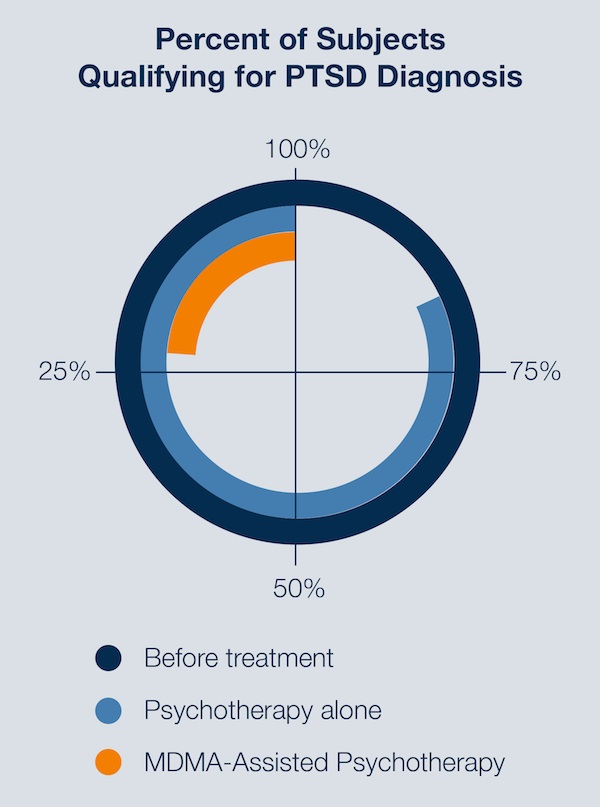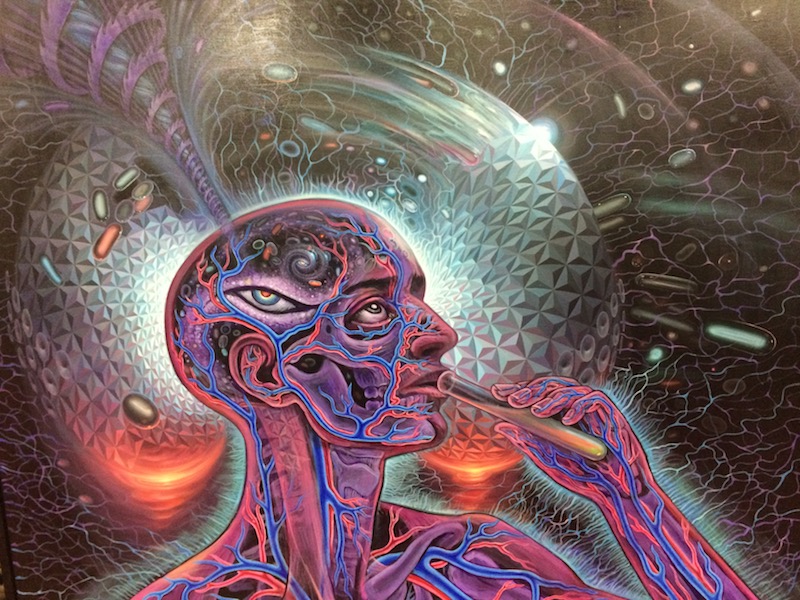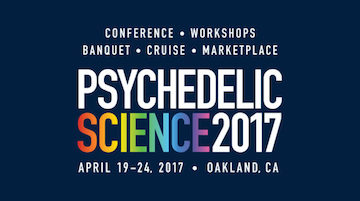I recently attended Psychedelic Science 2017 in Oakland, California. Overall it was a highly encouraging and impressive event, put on by MAPS and the Beckley Foundation. Here’s what I discovered at the conference.
1) There’s more psychedelic research going on than I’d ever imagined
Psychedelic Science 2017 was the largest psychedelic research conference ever. There were over 3,000 people in attendance, with two halls and two large conference rooms running presentations and talks from morning to evening for three days straight.
The conference featured three main tracks: clinical research, plant medicine, and interdisciplinary. Talks were on recently completed and ongoing research into the therapeutic, scientific, and spiritual uses of MDMA, LSD, psilocybin, ayahuasca, peyote, ketamine, ibogaine, marijuana and more. These compounds show promising results for treating PTSD, depression, anxiety, alcoholism, addiction, and a variety of other mental and physical ills.
You can see a full list of the research presented here. It is quite incredible.
The conference also featured a marketplace with visionary art, handcrafted and sustainable products, innovative technologies, a tea house, and other booths and stalls. There was also whole other stage run by online magazine Psymposia with stories, interviews, panels, presentations and more.
There were also community forums, poster sessions, film screenings, a comedy banquet, a sunset cruise around the San Francisco bay, and harm reduction and holotropic breathing workshops pre and post-conference.
Throughout the conference I went from talk to talk, trying to get in to those that looked most interesting, while running into people I knew or had met there and trying to enjoy the art, marketplace and community. It was hard to keep up with it all.
Talking to people on the last day, the general sentiment was of total mental saturation – we had seen and heard so much information that it just wasn’t possible to take in any more.
Needless to say, this is great. The entire event was live streamed and videos of all the talks will be available on the MAPS YouTube channel if they are not already.
2) MDMA will soon be prescription medicine
MDMA-assisted psychotherapy for PTSD has been MAPS’ flagship project and the most widely publicized psychedelic research to date. MDMA-assisted psychotherapy is faster, more cost-effective, and has significantly better treatment outcomes then existing methods for treating PTSD.

Not only does it cure most subjects of PTSD, MDMA-assisted psychotherapy is also optimal for working through the regulatory and political processes required to turn a controlled substance into a prescription medicine. There were a large number of talks on MDMA-assisted psychotherapy at Psychedelic Science 2017.
MAPS’ research is also strategic in that it avoids alienating either side of the political spectrum. Those who might otherwise oppose psychedelic research won’t argue with curing veterans of PTSD.
MAPS is currently the only organization funding MDMA research – pharmaceutical companies are not interested because they cannot patent MDMA.
Click here for a full infographic explaining the research
MAPS aims to have MDMA as prescription medicine by 2021. The progress with MDMA will continue to open the door for research and governmental reconsideration of other substances. This is very encouraging. You can learn more on the MAPS website.
3) Mystical experience occasioned through psychedelic use is no different than non-psychedelic mystical experience
I am fascinated by mystical experience. Mystical/peak/transcendent experiences are intimately connected with psychedelics, as psychedelics are probably the most reliable way to bring them about.
Any attempt to understand, classify, or deconstruct the most profound experiences available to human beings can seem superfluous. You can’t describe it, you can’t explain it, you can’t make sense of it – that’s the whole point.
Nonetheless, I believe it is important (and certainly interesting) to try. There are so many questions. What are the elements of mystical experience? Are there different kinds? If so, what are the commonalities and differences between them? Can we develop more accurate and useful ways of understanding them? Ultimately what “answers” can we get about the ineffable?
It seems we can get at least one answer, and to a question I have personally wondered about. Are psychedelic-induced mystical experiences different from those induced by other means like meditation, fasting, or holotropic breathing?

The answer comes from a paper published in October 2016 entitled Of Roots and Fruits: A Comparison of Psychedelic and Non-Psychedelic Mystical Experiences.
Researcher Alexander Belser presented the findings at Psychedelic Science 2017. The researchers conducted a survey of individuals who had a religious, spiritual, or mystical experience (RSME):
In this study, 739 self-selected participants reported the psychological impact of their RSMEs in an online study, and indicated whether or not they were induced by a psychedelic substance…. Of the 739 participants, 347 indicated that their RMSE was psychedelically induced, and 392 indicated that the RMSE was non-psychedelically induced. Experiences induced by psychedelic substances were rated as more mystical (p < .001, d = .75), resulted in a reduced fear of death (p < .01, d = .21), increased sense of purpose (p < .05, d = .18), and increased spirituality (p < .001, d = .28) as compared to non-psychedelically triggered RSMEs.
This data comes from a self-reported survey and so is not the same as randomized, double-blind placebo-controlled studies. But since there is a growing body of research demonstrating the profound and lasting benefits of mystical experience, it is interesting to see some data comparing the psychedelic and non-psychedelic. You can read more about the study here.
4) Dr. Bronner’s (yes, the soap) is doing a huge amount of good
I went over to the Dr. Bronner’s booth in the Psychedelic Science marketplace because I was curious about the connection between a soap company and psychedelics.
The guy at the booth seemed slightly suspicious at first and asked me about myself, seemingly sort of screening me, which I thought was funny since we were at a psychedelic conference.
Once he was assured we were on the same side he went on to tell me that Dr. Bronner’s provides huge financial support to a number of social causes, including marijuana legalization efforts and psychedelic research.
They are apparently the number one donor to marijuana legalization campaigns in a large number (I forget the exact number) of states. Dr. Bronner’s also recently pledged $5 million to MAPS’ MDMA-assisted psychotherapy research.
Dr. Bronner’s Pledges $5 Million to MAPS to Make MDMA into FDA-Approved Medicine to Treat PTSD https://t.co/7Z7QCVnBXK via @DrBronner
— Dr. Bronner's (@DrBronner) April 18, 2017
The guy at the booth explained that Dr. Bronner’s are able to do this because they are still a family-owned company, and they in fact donate 40% of pre-tax profits (!) to social causes. This is very admirable.
5) The psychedelic community holds some unique contrasts and tensions
Psychedelics are unique as objects of scientific and medical research, and the psychedelic community holds some unique contrasts, balances and tensions.
You have on one hand the tightly-controlled, purely rational-scientific approach with researchers in their suits and ties presenting results published in respected academic journals.
Then you have simultaneously what Rick Doblin called the celebratory aspects of psychedelics: visionary art, colourful clothing, music, free expression and the sense of community that form psychedelic culture.
Psychedelic Science 2017 balanced these elements well. The research was intellectually stimulating, the art was beautiful, and the afterparty on the last night was the most fun I’ve had in a long time.
There are, however, tensions within the movement. They remain manageable because the movement is still small enough that everyone stays united under a set of relatively homogenous common goals. But as we move forward some tensions may come to a head.
Doblin has always been careful to point out that we must avoid the mistakes of the 1960’s, and thus far we have managed to do so. One of these mistakes was conscious identification as the counter-culture. We are not the counter-culture, nor do we want to be. We are integrating psychedelics into the mainstream.
Nevertheless, there is disagreement over how this is best done. Some believe the purely rational-scientific approach is best, and that we should use the research to move through the complex regulatory processes according to the rules. This is a long and slow process but likely has the highest chances of success.
Others support a more aggressive political activism approach and there are conflicting views on whether we want to be, or want to be seen as, anti-establishment. If so, how anti-establishment do we want to be, and how do we want to act that out?
There is also tension is the plant medicine track, between performing controlled studies in the Western scientific/medical model and the traditional or ceremonial uses of these substances in indigenous cultures. There is broader tension regarding Westerners using these substances at all, including accusations of cultural appropriation as well as more understandable concerns about the plant species becoming extinct.
There is also an unfortunate creep of identity politics into the psychedelic movement. I witnessed this to some degree at Psychedelic Science 2017 and avoided it whenever possible. Psychedelics have historically been aligned with progressive values, and this has certainly made sense in the past.
But identity politics is poisonous and ultimately corrosive to everything it touches. Identity politics and similar ideologies have no place in the psychedelic movement. It’s possible that a conflict may arise in the future between those aligned with identity politics and the more rationally-minded members of the psychedelic movement. I hope it doesn’t get to that point, but we will see.
That is far from exhaustive and there are further potential pitfalls moving forward. Bob Jesse has an excellent talk on this which you can watch below.
Rick Doblin discussed some of these tensions in his closing speech and is remarkably able to remain level-headed about all of this. Doblin’s grounded energy, diligence and personal integrity in many ways remains the bedrock much of this is built on.
As time passes and the movement grows, some of these tensions may come to a head. Again, we will see.
6) Psychedelic Science 2017 shows the psychedelic movement is snowballing
Psychedelic Science 2017 was the largest psychedelic research conference in history – over double the size of the previous conference in 2013. There is a huge amount of research happening and more yet to come.
People from all over the world flew in to Oakland to attend, all for their own various reasons. But ultimately everyone is there because they believe in the cause.
I sat in a room with 50 or 60 people from all different countries, all running psychedelic societies in their home cities. We discussed strategies and best practices moving forward: how to organize events, publicize research findings, affect public attitudes, policy and more. This movement is growing fast.

Interacting with other conference attendees was inspiring. Contrary to the perception of drug users as degenerates or “bad people”, everyone I met at Psychedelic Science was friendly, positive, and respectful. It was good vibes all around.
What’s more, everyone was doing something: research, advanced degrees, working for MAPS or Beckley Foundation, authoring books, hosting podcasts, creating art, making films, organizing events, building communities and more.
Everyone is contributing in their own way and the psychedelic movement is largely made up of highly competent, informed, productive people. Witnessing this has been extremely inspiring and encouraging.
7) There’s never been a better time to get involved
If you’re interested in psychedelics, or the intersection of psychedelics and psychotherapy, consciousness research, cognitive science, education, psychology, or any related field, there has never been a better time to get involved.
Universities are increasingly researching the benefits of these substances and if you plan to do graduate work, you may be able to do it in this field.
If you are a student, you can seek out your local SSDP (Students for Sensible Drug Policy) chapter.
You can volunteer for organizations like MAPS, the Zendo Project, the Drug Policy Alliance, and DanceSafe.
You can donate to MAPS, Beckley Foundation, and Heffter Research Institute.
You can get involved with your local psychedelic society. Search “psychedelic society [your city]” on Facebook or the hashtag #FindTheOthers to find out if there’s a psychedelic society near you.
If there isn’t, you can start one. Register at Global Psychedelic Network to join the private online community for psychedelic societies around the world. GPN provides resources, guides, and best practices for running a psychedelic society, along with the opportunity to interact with others doing the same.
We are making this happen and now is the time to get involved. Feel free to ask any questions in the comments section and I hope to see you at a future event!
Read next: Fighting the War for Your Psychological Freedom: Drug Policy, Consciousness, and Our Future

